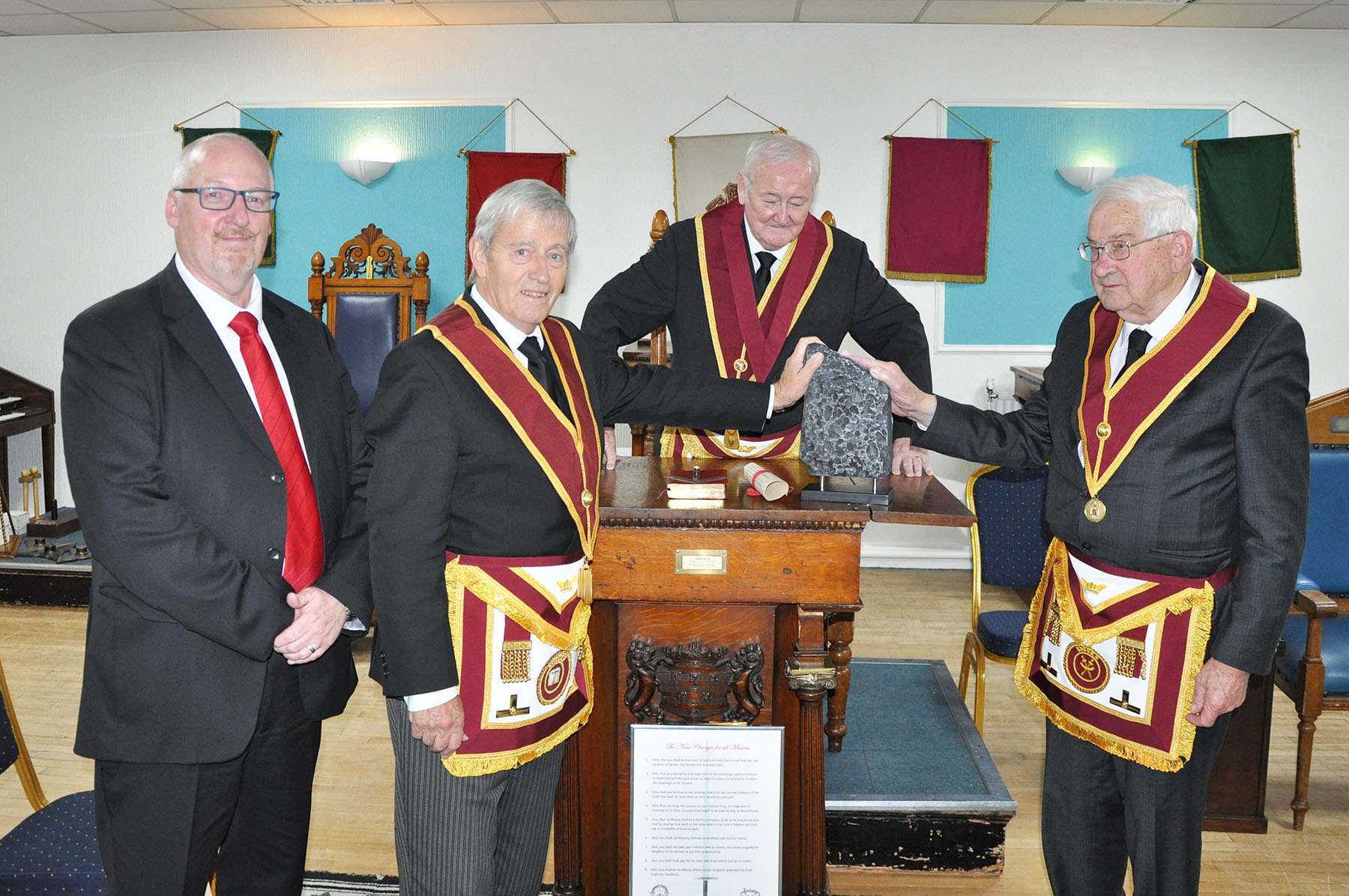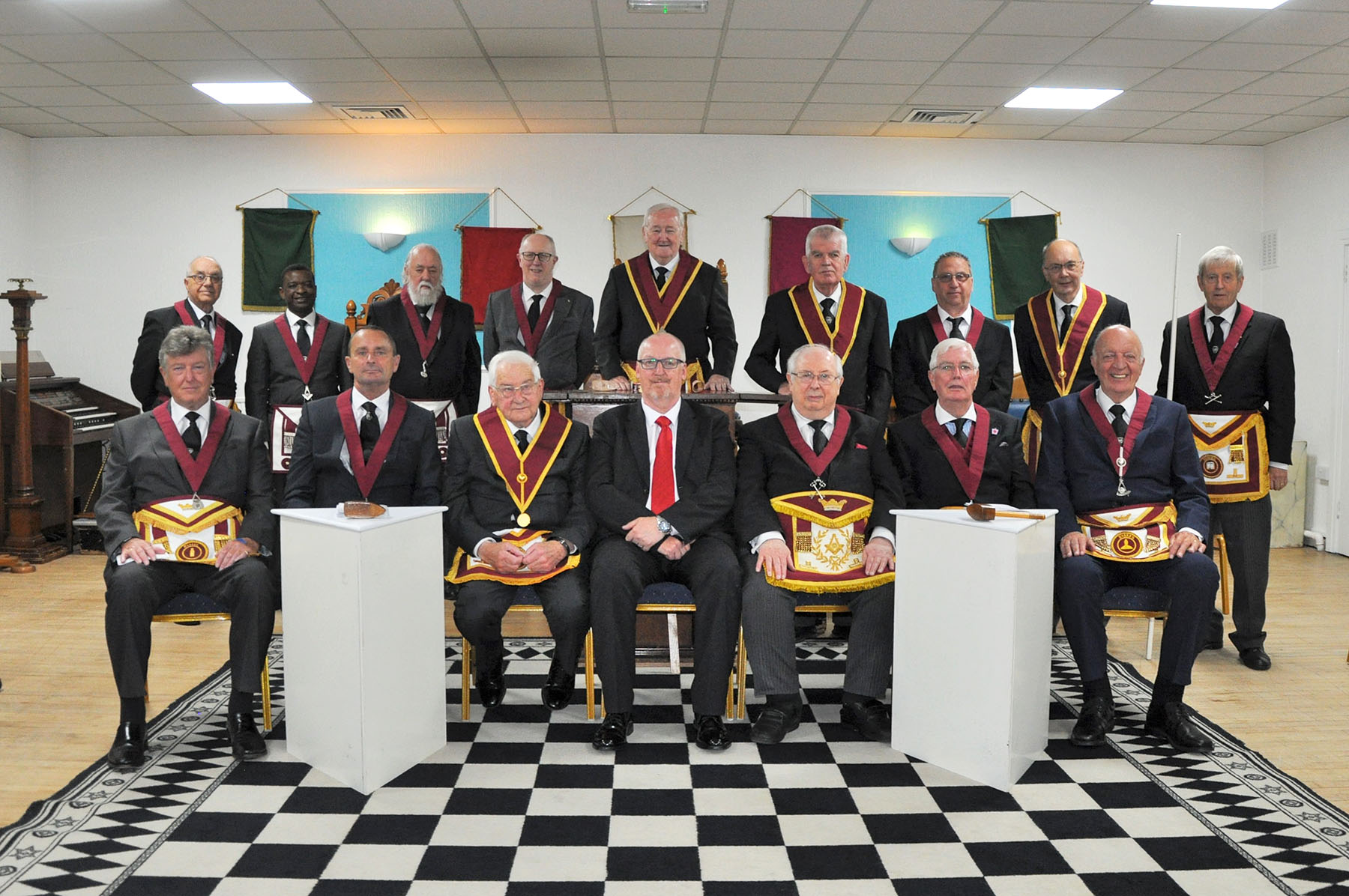The Sword of Constantine Court No 120 met on Monday the 10th of July at Croydon.
The Court was opened by the Worshipful Master, W.Bro. George Rodger, who welcomed everyone to the meeting. After the minutes had been confirmed Bro. Philipp Reutner was declared Worshipful Master for the ensuing year and W.Bro. Chris Cradock was declared Treasurer.
After the regular business of the Lodge was concluded the Court was closed and the Temple was prepared for a talk. Brother Michael Brewster was invited into the Temple to hear the talk entitled ‘The Rosetta Stone’. The talk was written by W.Bro. Gordon Smith, who joined us at the meeting.


The Brethren of the Sword of Constantine Court found the talk very informative and thanked Bro. Gordon for allowing us to present it.

The Brethren of the Sword of Constantine Court sat down to a curry meal with our two guests who said they had a most enjoyable time at an Athelstan meeting.
Article and photos by Chris Eley
< return to News Index

The Court was opened by the Worshipful Master, W.Bro. George Rodger, who welcomed everyone to the meeting. After the minutes had been confirmed Bro. Philipp Reutner was declared Worshipful Master for the ensuing year and W.Bro. Chris Cradock was declared Treasurer.
After the regular business of the Lodge was concluded the Court was closed and the Temple was prepared for a talk. Brother Michael Brewster was invited into the Temple to hear the talk entitled ‘The Rosetta Stone’. The talk was written by W.Bro. Gordon Smith, who joined us at the meeting.

The Rosetta Stone is a stele composed of granodiorite inscribed with three versions of a decree issued in Memphis, Egypt, in 196 BC during the Ptolemaic dynasty on behalf of King Ptolemy V Epiphanes.
The top and middle texts are in Ancient Egyptian using hieroglyphic and Demotic scripts respectively, while the bottom is in Ancient Greek. The decree has only minor differences between the three versions, making the Rosetta Stone key to deciphering the Egyptian scripts.
The stone was carved during the Hellenistic period and is believed to have originally been displayed within a temple, possibly at Sais. It was probably moved in late antiquity or during the Mamluk period and was eventually used as building material in the construction of Fort Julien near the town of Rashid (Rosetta) in the Nile Delta. It was found there in July 1799 by French officer Pierre-François Bouchard during the Napoleonic campaign in Egypt.
It was the first Ancient Egyptian bilingual text recovered in modern times, and it aroused widespread public interest with its potential to decipher this previously untranslated hieroglyphic script. Lithographic copies and plaster casts soon began circulating among European museums and scholars. When the British defeated the French, they took the stone to London under the Capitulation of Alexandria in 1801. Since 1802, it has been on public display at the British Museum almost continuously and is its most visited object.
The talk was presented by W. & Em. Bro. Chris Eley with commentary from Bro. Gordon.The top and middle texts are in Ancient Egyptian using hieroglyphic and Demotic scripts respectively, while the bottom is in Ancient Greek. The decree has only minor differences between the three versions, making the Rosetta Stone key to deciphering the Egyptian scripts.
The stone was carved during the Hellenistic period and is believed to have originally been displayed within a temple, possibly at Sais. It was probably moved in late antiquity or during the Mamluk period and was eventually used as building material in the construction of Fort Julien near the town of Rashid (Rosetta) in the Nile Delta. It was found there in July 1799 by French officer Pierre-François Bouchard during the Napoleonic campaign in Egypt.
It was the first Ancient Egyptian bilingual text recovered in modern times, and it aroused widespread public interest with its potential to decipher this previously untranslated hieroglyphic script. Lithographic copies and plaster casts soon began circulating among European museums and scholars. When the British defeated the French, they took the stone to London under the Capitulation of Alexandria in 1801. Since 1802, it has been on public display at the British Museum almost continuously and is its most visited object.

The Brethren of the Sword of Constantine Court found the talk very informative and thanked Bro. Gordon for allowing us to present it.

The Brethren of the Sword of Constantine Court sat down to a curry meal with our two guests who said they had a most enjoyable time at an Athelstan meeting.
Article and photos by Chris Eley
< return to News Index


